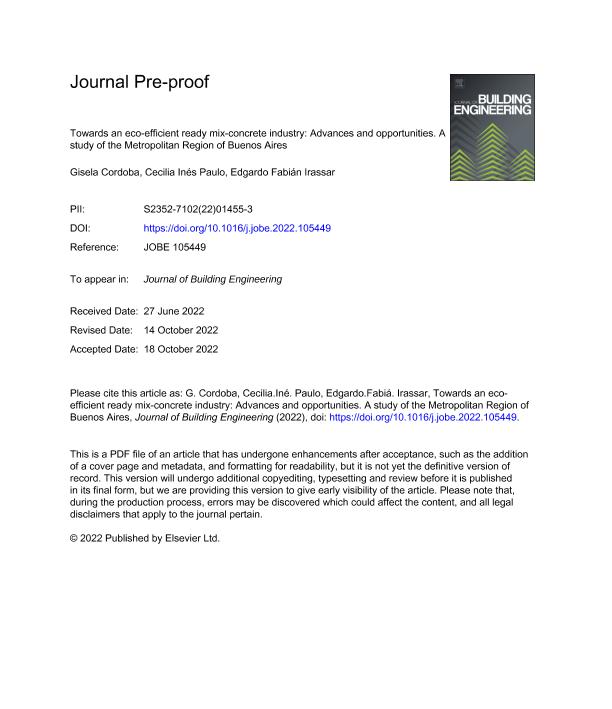Mostrar el registro sencillo del ítem
dc.contributor.author
Cordoba, Gisela Paola

dc.contributor.author
Paulo, Cecilia Inés

dc.contributor.author
Irassar, Edgardo Fabián

dc.date.available
2024-04-18T11:54:42Z
dc.date.issued
2023-01
dc.identifier.citation
Cordoba, Gisela Paola; Paulo, Cecilia Inés; Irassar, Edgardo Fabián; Towards an eco-efficient ready mix-concrete industry: Advances and opportunities. A study of the Metropolitan Region of Buenos Aires; Elsevier; Journal of Building Engineering; 63; 1-2023; 1-36
dc.identifier.issn
2352-7102
dc.identifier.uri
http://hdl.handle.net/11336/233404
dc.description.abstract
There is a growing demand in Latin America and the Caribbean for building materials to satisfy the need for adequate housing and infrastructure in urban areas. This paper examines the consumption of materials and environmental impact of ready-mix concrete produced in the Metropolitan Region of Buenos Aires in a certain period of time. Material flow analysis and life cycle assessment (LCA) were performed. The average composition concrete was estimated by means of surveys conducted with ready-mix concrete producers. The material efficiency (ME), CO2 equivalent emissions (ECO2eq), materials and energy use were used as environmental indicators. Feasible impact reduction strategies and their influence on the LCA were also explored. 7.16 Mt of materials were required to produce 2,604,862 m3 of ready-mix concrete, within 99.1% corresponded to raw materials, while 0.9% corresponded to secondary raw materials. 5.36 Mt (~78.6%) of the extracted materials belong to aggregate production and they represent ~19.5% of the ECO2eq. Portland cement is the largest contributor to ECO2eq and the constituent material with the lowest ME. Using recycled aggregates is the strategy that contributes the most to the reduction of the use of raw materials (~8.9% lower use of raw material by using 20% recycled coarse aggregate), while replacing Portland cement with supplementary cementitious materials (SCM) is the one that reduce the most the ECO2eq (the use of Portland cement without SCM would increase ECO2eq by ~13.6%). This research provides a novel approach that quantifies the effect of modifying the concrete mix and replacing raw materials by secondary raw materials, bringing a new understanding to the sustainability of building materials.
dc.format
application/pdf
dc.language.iso
eng
dc.publisher
Elsevier

dc.rights
info:eu-repo/semantics/openAccess
dc.rights.uri
https://creativecommons.org/licenses/by-nc-sa/2.5/ar/
dc.subject
READY-MIX CONCRETE
dc.subject
MATERIAL FLOW ANALYSIS (MFA)
dc.subject
LIFE CYCLE ASSESSMENT (LCA)
dc.subject
MATERIAL EFFICIENCY
dc.subject.classification
Otras Ingeniería de los Materiales

dc.subject.classification
Ingeniería de los Materiales

dc.subject.classification
INGENIERÍAS Y TECNOLOGÍAS

dc.title
Towards an eco-efficient ready mix-concrete industry: Advances and opportunities. A study of the Metropolitan Region of Buenos Aires
dc.type
info:eu-repo/semantics/article
dc.type
info:ar-repo/semantics/artículo
dc.type
info:eu-repo/semantics/publishedVersion
dc.date.updated
2024-04-17T12:22:53Z
dc.journal.volume
63
dc.journal.pagination
1-36
dc.journal.pais
Países Bajos

dc.description.fil
Fil: Cordoba, Gisela Paola. Universidad Nacional del Centro de la Provincia de Buenos Aires. Centro de Investigaciones en Física e Ingeniería del Centro de la Provincia de Buenos Aires. - Consejo Nacional de Investigaciones Científicas y Técnicas. Centro Científico Tecnológico Conicet - Tandil. Centro de Investigaciones en Física e Ingeniería del Centro de la Provincia de Buenos Aires. - Provincia de Buenos Aires. Gobernación. Comisión de Investigaciones Científicas. Centro de Investigaciones en Física e Ingeniería del Centro de la Provincia de Buenos Aires; Argentina
dc.description.fil
Fil: Paulo, Cecilia Inés. Universidad Nacional del Centro de la Provincia de Buenos Aires. Centro de Investigaciones en Física e Ingeniería del Centro de la Provincia de Buenos Aires. - Consejo Nacional de Investigaciones Científicas y Técnicas. Centro Científico Tecnológico Conicet - Tandil. Centro de Investigaciones en Física e Ingeniería del Centro de la Provincia de Buenos Aires. - Provincia de Buenos Aires. Gobernación. Comisión de Investigaciones Científicas. Centro de Investigaciones en Física e Ingeniería del Centro de la Provincia de Buenos Aires; Argentina
dc.description.fil
Fil: Irassar, Edgardo Fabián. Universidad Nacional del Centro de la Provincia de Buenos Aires. Centro de Investigaciones en Física e Ingeniería del Centro de la Provincia de Buenos Aires. - Consejo Nacional de Investigaciones Científicas y Técnicas. Centro Científico Tecnológico Conicet - Tandil. Centro de Investigaciones en Física e Ingeniería del Centro de la Provincia de Buenos Aires. - Provincia de Buenos Aires. Gobernación. Comisión de Investigaciones Científicas. Centro de Investigaciones en Física e Ingeniería del Centro de la Provincia de Buenos Aires; Argentina
dc.journal.title
Journal of Building Engineering
dc.relation.alternativeid
info:eu-repo/semantics/altIdentifier/doi/https://doi.org/10.1016/j.jobe.2022.105449
Archivos asociados
